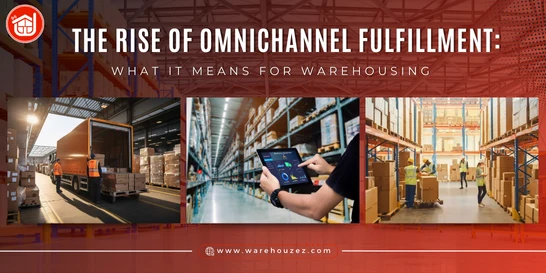Sustainable Warehousing: Implementing Eco-friendly Practices in Supply Chain
Sustainable Warehousing: Implementing Eco-friendly Practices in Supply Chain
The supply chain and warehouse management operations can have a substantial impact on the environment, both positively and negatively. As such, it has become increasingly critical that companies prioritize environmental initiatives while handling their products and services to reduce our dependence on fossil fuels and reduce our CO2 emissions as much as possible. Sustainable warehousing is key to implementing eco-friendly practices in the supply chain.
This blog covers the various aspects of incorporating sustainability into warehousing operations, from implementing energy-efficient lighting and equipment to investing in renewable energy sources. These cost-saving measures are not only beneficial for the environment but also provide financial stability and competitive advantages for companies.
What is Sustainable Warehousing?
In simple terms, sustainable warehousing refers to the practice of integrating ethical and environmental practices into the storage and warehousing operations of a company. By prioritizing green initiatives, companies can ensure that their warehouses are as efficient and eco-friendly as possible. This includes utilizing materials and technologies that reduce energy usage, excess packaging, and emissions. Furthermore, sustainable warehouse management includes optimizing warehouse layouts, taking advantage of automation and robotic technologies, implementing corrective maintenance techniques, and using renewable energy sources such as solar and wind power. In all likelihood, sustainable warehousing helps create a cleaner and healthier environment while eliminating unnecessary waste and energy costs.
The Need for Sustainability in the Supply Chain
The need for sustainability in the supply chain has become increasingly important in recent years due to the fact that resources used in the supply chain somehow have a negative impact on the environment. Sustainability involves reducing energy consumption, increasing the efficiency of delivery, and reducing the cost of manufacturing and distribution. This will ensure that businesses are not only using resources responsibly but also mitigating the environmental impact of their operations while ensuring a healthy balance between profits and sustainability. Furthermore, by integrating green initiatives into the supply chain, businesses can benefit from increased customer loyalty, improved customer satisfaction, and a better reputation as environmentally conscious companies.
Sustainable Practices for a Greener Future
In the most inclusive sense, sustainable warehousing practices are those strategies that help reduce a warehouse's environmental impact and promote long-term environmental stewardship.
Let's now take a closer look at practices that promote environmental sustainability and a greener future.
Eliminating Waste
Warehouses have many opportunities when it comes to reducing waste, such as reusing packaging materials, reducing supply overstock, and recycling waste. By implementing strategies such as facility-level waste-elimination initiatives, warehouses can save money, conserve resources, and increase efficiency.
Invest in Efficient Equipment
In recent times, warehousing companies have considered investing in efficient and eco-friendly equipment like forklifts and automated storage and retrieval systems (AS/RS) that run on electricity instead of gasoline.
Leveraging Automation Technologies
Automation is an important factor in sustainable warehousing practices. Automated processes such as material handling equipment, automated storage and retrieval systems, and warehouse management systems can all help reduce energy and labor costs, minimize environmental impact, and improve warehouse efficiency.
Reduce Emissions and Energy Use
Warehouses that use transportation to move goods should rethink how they move goods while reducing emissions from diesel and petrol vehicles. For example, they can switch to electric vehicles or use eco-friendly alternative fuels. Additionally, sustainable practices in warehouse management involve reducing energy use as much as possible. This can include turning off lights or equipment when not in use, upgrading to energy efficient lighting and equipment, and utilizing natural lighting or natural ventilation to increase efficiency.
Recycle and Reuse Materials
Diverting materials such as cardboard boxes, shrink wrap, and other packaging materials away from landfills and into recycling or reuse outlets can help reduce waste at the warehouse.
Utilize Renewable Energy Sources
Utilizing renewable energy sources like solar and wind can help reduce the carbon footprint left by traditional sources of power. This involves investing in renewable energy technologies, and by doing so, warehouses can save costs in the long run while doing their bit for the environment.
Sustainable Warehousing: Benefits for Companies, the Environment, and Society
It goes without saying that sustainable warehousing has become an increasingly important topic in recent years, as companies look to reduce their environmental footprint and ensure their operations are socially responsible. From cost savings to emissions reductions, sustainability in warehousing offers a wealth of benefits for businesses, the environment, and society as a whole. Let's explore these benefits:
Cost Savings
Many warehouses that employ sustainable methods can benefit from significant cost savings. Energy efficient lighting, climate control, and other measures help reduce waste in both energy costs and materials. This in turn leads to lower operating expenses, with lower energy bills and the use of fewer and cheaper materials to keep operational costs down.
Enhanced Customer Satisfaction
Sustainable warehousing practices often result in shorter shipping times and a reduction in order mix-ups, which can lead to improved customer satisfaction.
Improved Quality of Inventory
Prioritizing sustainability initiatives can lead to better tracking and management of inventory, improving the quality and accuracy of inventory control. This reduces the risk of product damage or expiration and makes it easier to identify defective items that need to be replaced or sent back to suppliers.
Heightened Staff Morale
Research has found that implementing green initiatives can lead to increased employee morale, as well as improved employee satisfaction, commitment, and motivation. Green warehouses use environmentally friendly methods which allow employees to work more efficiently and have better cheerfulness and morale.
Minimized Environmental Impact
Practicing green initiatives helps reduce the amount of unnecessary items being placed in landfills, which can in turn decrease the negative environmental impacts of warehouses. Additionally, sustainable warehousing strategies may include the use of renewable energy sources, such as solar panels, to power the warehouse.
Wrapping Up
To wrap things up, sustainable warehousing practices are key to maintaining a profitable and resilient supply chain in the long-term. Investing in environmentally-friendly technologies, such as energy-saving lighting or automated warehouses, can help warehouses reduce their carbon footprint and maintain their competitive advantage. Furthermore, given the growing awareness of environmental concerns among consumers, eco-friendly practices can also be a boon to a company’s public image. By taking steps to lower their emissions and environmental impacts, warehouses can take a step in the right direction towards building a more sustainable and resilient supply chain.



